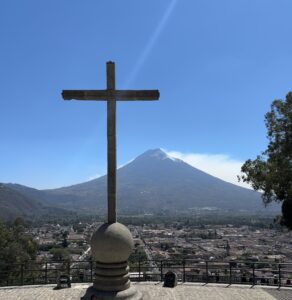by Mary | Sep 21, 2010 | book review, Books
Catholic columnist Therese Borchard wrote a review of my new book, “Walking Together: Discovering the Catholic Tradition of Spiritual Friendship,” which has been published in various Catholic newspapers.
Here it is:
By Therese J. Borchard
9/8/10
I’ve long known the truth of Martin Buber’s line: “When two people relate to each other authentically and humanly, God is the electricity that surges between them.”
It’s the same message that Jesus speaks in Matthew 18:20: “For where two or three come together in my name, there I am with them.”
I have always been intrigued and fascinated by the classic stories of spiritual friendship, especially in the Catholic tradition: Francis of Assisi and Clare, Thérèse of Lisieux and Maurice Bellière, Teresa of Avila and John of the Cross, Hildegard of Bingen and Bernard of Clairvaux, Dorothy Day and Peter Maurin, and Peter Abelard and Heloise.
It was with great interest, then, that I read Walking Together: Discovering the Catholic Tradition of Spiritual Friendship, by journalist Mary DeTurris Poust. Her text examines examples of spiritual friendship from well-known saints, writers and modern religious leaders and gives instructions on how to cultivate meaningful relationships in a world where people feel increasingly isolated despite all the technology and social networking tools designed to keep us connected.
Why are spiritual friendships important?
Poust explains, “Spiritual friendship(s) (are) connected to our God-given mission, our calling to live out our faith in the everyday world. … They are not about possession but about transformation.”
However, these bonds aren’t entirely up to us to form. Poust quotes Christian apologist C.S. Lewis, who reminds us that God chooses our companions for us. Lewis asserts, “The friendship is not a reward for our discrimination and good taste in finding one another out. It is the instrument by which God reveals to each the beauties of all the others…Continue reading HERE.
by Mary | Sep 20, 2010 | Books

Bishop Hubbard was kind enough to sit down and share with me his own story of lifelong spiritual friendship with Bishop Matthew Clark of Rochester. Their friendship opens chapter 10 of my book, a chapter that focuses not only on pilgrimage to sacred places but pilgrimage to an interior place. In that chapter, I talk about my first pilgrim visit to Auriesville. So things came full circle on Saturday when everything aligned to bring us together in that beautiful spot along the Mohawk River.
Thank you again to Bishop Hubbard for being so honest and open about his own faith journey, his friendship, and his spiritual struggles. I know his story will inspire others.
You can pre-order my book by clicking
HERE for amazon.com,
HERE for Ave Maria Press, or
HERE for B&N.com. Its official release date is Nov. 1.
by Mary | Sep 19, 2010 | Travel
 I’m in a pilgrim state of mind, so it seemed like a natural segue to go from sacred places in Rome to sacred places in upstate New York. One of my favorite pilgrimage sites only 45 minutes from my house is the Shrine of the North American Martyrs (above), where Blessed Kateri Tekakwitha was born and where Jesuit priests Isaac Jogues and Rene Goupil and lay missioner John LaLande where martyred. It’s a beautiful spot soaked with a spirituality that resonates with every step.
I’m in a pilgrim state of mind, so it seemed like a natural segue to go from sacred places in Rome to sacred places in upstate New York. One of my favorite pilgrimage sites only 45 minutes from my house is the Shrine of the North American Martyrs (above), where Blessed Kateri Tekakwitha was born and where Jesuit priests Isaac Jogues and Rene Goupil and lay missioner John LaLande where martyred. It’s a beautiful spot soaked with a spirituality that resonates with every step.
I was there this weekend for a Boy Scout Mass, where Noah received his Ad Altare Dei award along with seven other boys from our troop. It was a beautiful day at a beautiful place. Here are a few photos from the visit.
In the ravine, where Isaac Jogues buried the body of Rene Goupil. You can read the story in Isaac Jogues’ own words:
 Our Lady of the Way:
Our Lady of the Way:

One of many crosses on trees around the shrine:

The end of the ravine trail:
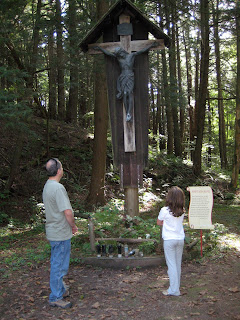 Along the path:
Along the path:
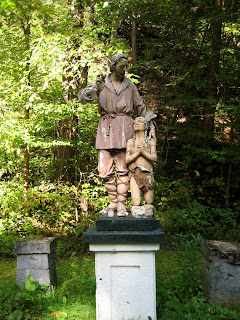

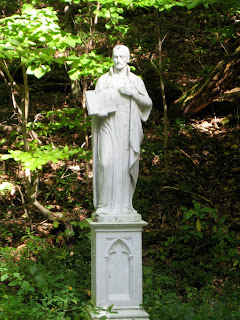

Heading to Mass through the main entrance of the shrine:
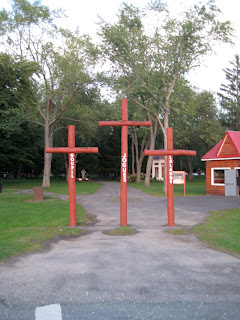
Stopping for a moment of prayer:


Seven Sorrows of Our Lady:

A reminder of the shrine’s importance in Catholic history:

Our group with Bishop Hubbard after Mass:
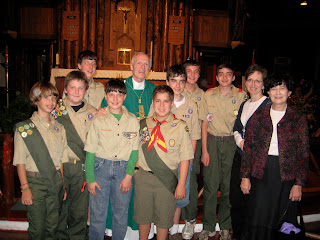
by Mary | Sep 18, 2010 | Uncategorized

Having come of age in the era just post Vatican II, I never experienced the “old” Mass. Although my parish did have a Communion rail in its chapel, where I received Communion often, my general experience of the Mass growing up was of the groovy variety, with lots of Kumbayas and felt banners. Not that there’s anything wrong with that.
So when I got to Rome, I was in for a little spiritual culture shock. Because the churches are so old, the altars are built into the wall under the tabernacle. What does that mean? It means the priest has no choice but to celebrate Mass with his back to the congregation. If you had asked me before my recent pilgrimage to Rome how I would feel about this change of positions, I probably would have expected it to be a little off-putting. Turns out it was anything but.
At the risk of setting myself up for a wave of comments, I have to say that I LOVED attending Mass this way. Why? Because I felt it was a great equalizer. Rather than seeing the priest in a position of power, facing me, almost as if performing for the congregation, I saw him as praying with me. He was facing God as I was facing God. We were in it together, looking heavenward as one rather than looking at each other.
I was fortunate enough to attend multiple Masses in Rome, but the ones with the most impact and where the priest-facing-away situation felt the most powerful, were in St. Peter’s Basilica and in Chiesa Nouva at a Mass celebrated in front of the body of St. Philip Neri. Both had an intimate feel — the Mass at St. Peter’s was in a side chapel to Our Lady of Perpetual Help — and both made me feel as though the priest was one with the congregation, even when the congregation was just me and an OSV colleague (as in St. Peter’s).
So that’s my new perspective on an old tradition. Let’s hear how you feel about this in the comment section?
by Mary | Sep 15, 2010 | family, Life Lines

My most recent Life Lines column:
A couple of recent events have forced me to focus on the idea of “detachment,” letting go of those things that threaten to control us, consume us, or, at the very least, use up a lot of our energy and time unnecessarily. In our world today, detachment is most often talked about in reference to material things. In fact, it’s almost a bit of a fad. People want to live more simply, downsize their houses, buy local, go green.
For me, the material stuff isn’t so much the issue. I don’t need the big TV or expensive shoes. It’s the less tangible things that I seem to have to disentangle myself from. It makes me think of the passage from Luke 14:26, when Jesus says, “If anyone comes to me without hating his father and mother, wife and children, brothers and sisters, and even his own life, he cannot be my disciple.” For a long time that reading just didn’t resonate with me. How could we “hate” our mother and father, our brothers and sisters? But, as usual, Jesus wasn’t talking literally but in story form, trying to teach us a bigger concept.
Putting messianic prophecies aside (because so much of what Jesus said meant more to the Jews of his time than any of us can understand without a Bible scholar on hand), this passage is a reminder to us of where God needs to be in our lives. Of course we’re not supposed to hate the people close to us. After all, Jesus told us we were to love everyone, even our enemies, so I think it’s fair to say we’re supposed to love our family. But those relationships cannot become so all-consuming that they get in the way of our relationship with God.
So that’s what I’ve been thinking about these days. We go through life trying to fulfill certain roles in our immediate families, our extended families, our circle of friends, our community. Sometimes we don’t even stop to think whether that role is good for us or for anyone else; it’s just what we do because, well, aren’t we supposed to do it? No, as it turns out.
Our job is to love God first and let everything else fall into place. Detachment, I think, is a natural byproduct of the God-centered life. So, when we can’t make a family member love us, we find a way to love them anyway and let go. When our children start to spread their wings and we have the urge to mold them in our own image, we find a way to pull back and let them choose their own path. When we can’t be all things to all people, we find a way to step aside and quickly realize that things move forward without us.
Still, it’s not an easy thing to do, this detaching. Human nature makes us want to hold on for dear life, whether it’s to our possessions, our children, our larger family, or something even less tangible than that — our fears, our expectations, our self image.
I think I learned the greatest lesson in detachment when my mother died more than 22 years ago. Despite our physical separation, I realized — perhaps slowly as the initial grief began to fade — that the bond we shared transcended time and space. It remains for all time, and that’s a beautiful gift and a powerful lesson.
It’s only when we let go of our need to hold onto people and things that we finally experience the depth of love we were hungering for. It’s only when we remove the mask we put on for the world and face our true selves squarely in the mirror that we finally have the opportunity become the people we were created to be. It’s only when we love God first that we finally learn to love those around us more perfectly.
To read previous Life Lines columns, click HERE.



